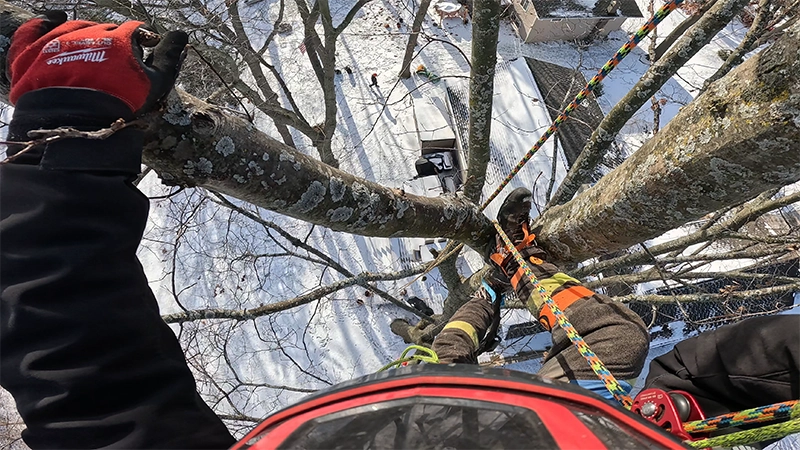Most people think winter is the perfect time to relax when it comes to tree care. However, certified arborists know better. Winter is the best time of year for trimming trees, and the benefits extend far beyond aesthetic appeal. In this article we explain the importance of tree trimming in winter and why now is the best time.
At Ascension Tree Care, year-round tree care involves winter pruning or trimming.
Just because it’s winter, or the season is dormant, doesn’t mean you just let nature take its course until spring.

Below, we’ll answer why winter tree trimming is necessary and how it promotes healthier, safer, and more beautiful trees.
Benefits of Winter Tree Trimming
Winter is not only convenient for tree care; it’s the season that best supports long-term growth and health.
Here are some of the best reasons why:
Dormant Pruning Advantages
Taking out branches during this time lowers stress on the tree while promoting a quicker recovery when spring comes.
Then, dormant pruning ensures better visibility, letting arborists find structural problems or deadwood with precision.
Stress Reduction for Trees
Tree pruning during active growth seasons, like spring or late fall, exposes fresh cuts to harsh conditions and weather in general, potentially disfiguring the tree.
This is a really big deal if you’re into aesthetics.
One of the main advantages of winter pruning is that you’re not pruning any photosynthetic material off the tree.
The leaves are already off, meaning that you’re not influencing the amount of photosynthesis or energy uptake that the tree can perform.
Winter pruning allows a tree to hopefully have a full summer, fall, and spring growth without interruptions.
Fun fact: Late winter trimming promotes optimal wound closure before the arrival of pathogens and insects.
Enhanced Growth in Spring
Winter trimming prepares your trees for vigorous growth in spring.
When done right, it directs the tree’s energy toward healthy branches and buds.
This is good news for fruit trees, as it enhances flower and fruit production.
Decreased Disease Risk
Pruning in the wintertime drastically lowers the chances of disease transmission.
Many harmful pathogens, like those that cause oak wilt or Dutch elm disease, are inactive or just as dormant as the trees in colder temperatures.
With dormant pests and fungal spores, the colder months are the safest time to address any diseased, dying, or damaged branches.
Ideal Trees for Winter Trimming
Not all trees benefit equally from winter pruning.
However, fruit trees, deciduous species, and oaks respond exceptionally well to trimming during the colder months.
Emphasizing structural integrity and removing problematic branches allows arborists to shape these trees for long-term health and beauty.
Which Trees Benefit From Winter Pruning
Certain tree species benefit from being pruned in the winter season.
Here’s how this dormant season benefits oaks, maples, elms, and fruit trees.

Oaks
Oak wilt is a fungal disease spread by insects active in warmer months.
It is fatal to oaks.
Winter trimming ensures fresh cuts are not exposed to these pests, lowering the chances of infection.
Maples and Elms
Although sap is not necessarily bad for maples and elms, it attracts pests and creates unsightly conditions.
Winter pruning minimizes sap flow and manages diseases like Dutch elm disease, as beetles spreading it are dormant in cold weather.
Fruit Trees
Pruning fruit trees like apples and cherries in winter enhances air circulation, sunlight exposure, and bud development.
This strengthens branches and improves their overall fruit production.
Trees To Avoid Pruning in Winter
Certain trees and conditions make winter a less-than-ideal time to prune trees.
Trees under environmental stress͏, such as those suffering from drought, pest infestations, or extreme cold, may struggle to recover during the dormant season.
Some trees, like birche͏s, walnuts, and maple͏͏s, are prone to sap bleeding if you prune them in late winter.
While sap bleeding doesn’t hurt the tree, it can make a mess and ͏isn͏’t ideal.
Safety Considerations for Winter Trimming
Winter weather can make tree maintenance and t͏rimming trickier than usual.
Stable Ground Conditions
Frozen ground͏ allows arborists͏ to͏ access trees without damaging your landscape.
The stability provided by frozen soil is invaluable when using heavy equipment for͏ large-scale pruning or tree removal.
Protecting Your Property
Winter storms ͏can add weight to we͏a͏k or dead branches, causing them to snap and fall.
Trimming those branches, ͏n͏ow can prevent damage to your home, car, or power lines.
Winter tree pruning might just be the smartest ͏move ͏you make t͏his season.
Why Choose Ascension Tree Care?
Situated in Milford and serving Oakland County, Michigan, Ascension Tree Care gives expert services that prioritize the health and safety of your trees.
Our certified arborists specialize in responsible trimming practices that enhance structural integrity and prevent common issues like topping or over-pruning.
From crown reduction to elevation pruning, we provide customized services to meet your trees’ needs.
